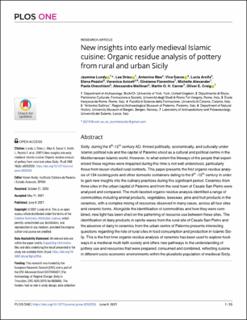| dc.contributor.author | Lundy, Jasmine | |
| dc.contributor.author | Drieu, Lea | |
| dc.contributor.author | Meo, Antonino | |
| dc.contributor.author | Sacco, Viva | |
| dc.contributor.author | Arcifa, Lucia | |
| dc.contributor.author | Pezzini, Elena | |
| dc.contributor.author | Aniceti, Veronica | |
| dc.contributor.author | Fiorentino, Girolamo | |
| dc.contributor.author | Alexander, Michelle | |
| dc.contributor.author | Orecchioni, Paola | |
| dc.contributor.author | Mollinari, Alessandra | |
| dc.contributor.author | Carver, Martin O. H. | |
| dc.contributor.author | Craig, Oliver E. | |
| dc.date.accessioned | 2022-03-21T09:32:42Z | |
| dc.date.available | 2022-03-21T09:32:42Z | |
| dc.date.created | 2022-01-26T08:54:30Z | |
| dc.date.issued | 2021 | |
| dc.identifier.issn | 1932-6203 | |
| dc.identifier.uri | https://hdl.handle.net/11250/2986368 | |
| dc.description.abstract | Sicily, during the 9th-12th century AD, thrived politically, economically, and culturally under Islamic political rule and the capital of Palermo stood as a cultural and political centre in the Mediterranean Islamic world. However, to what extent the lifeways of the people that experienced these regimes were impacted during this time is not well understood, particularly those from lesser studied rural contexts. This paper presents the first organic residue analysis of 134 cooking pots and other domestic containers dating to the 9th -12th century in order to gain new insights into the culinary practices during this significant period. Ceramics from three sites in the urban capital of Palermo and from the rural town of Casale San Pietro were analysed and compared. The multi-faceted organic residue analysis identified a range of commodities including animal products, vegetables, beeswax, pine and fruit products in the ceramics, with a complex mixing of resources observed in many cases, across all four sites and ceramic forms. Alongside the identification of commodities and how they were combined, new light has been shed on the patterning of resource use between these sites. The identification of dairy products in calcite wares from the rural site of Casale San Pietro and the absence of dairy in ceramics from the urban centre of Palermo presents interesting questions regarding the role of rural sites in food consumption and production in Islamic Sicily. This is the first time organic residue analysis of ceramics has been used to explore foodways in a medieval multi-faith society and offers new pathways to the understanding of pottery use and resources that were prepared, consumed and combined, reflecting cuisine in different socio-economic environments within the pluralistic population of medieval Sicily. | en_US |
| dc.language.iso | eng | en_US |
| dc.publisher | Public Library of Science | en_US |
| dc.rights | Navngivelse 4.0 Internasjonal | * |
| dc.rights.uri | http://creativecommons.org/licenses/by/4.0/deed.no | * |
| dc.title | New insights into early medieval Islamic cuisine: Organic residue analysis of pottery from rural and urban Sicily | en_US |
| dc.type | Journal article | en_US |
| dc.type | Peer reviewed | en_US |
| dc.description.version | publishedVersion | en_US |
| dc.rights.holder | Copyright 2021 Lundy et al. | en_US |
| dc.source.articlenumber | e0252225 | en_US |
| cristin.ispublished | true | |
| cristin.fulltext | original | |
| cristin.qualitycode | 1 | |
| dc.identifier.doi | 10.1371/journal.pone.0252225 | |
| dc.identifier.cristin | 1990056 | |
| dc.source.journal | PLOS ONE | en_US |
| dc.identifier.citation | PLOS ONE. 2021, 16 (6), e0252225. | en_US |
| dc.source.volume | 16 | en_US |
| dc.source.issue | 6 | en_US |

